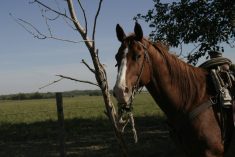LACOMBE, Alta. – Andrew Wildeboer says building a dairy barn around a robotic milking system has saved him time and labour so that he can take better care of his cows.
“I find I have more time. I know my cows better than I did before.”
Wildeboer is an auctioneer who is away 60 to 70 days a year, so he and his wife, Anna, decided to automate the milking system rather than building a parlour on their Lacombe area farm.
They do not have enough help for the 365-day-a-year commitment to chores on a dairy farm.
Read Also

Rural Manitoba resources slim on natural disaster planning
A study from Brandon University’s Rural Development Institute has found that many rural and small municipalities don’t have the staff or resources to make formal climate plans against natural disaster.
The computerized system milks the 60 Holsteins cows at least three times a day.
The Wildeboers started Chubanna Holsteins with 20 cows in 2002 and expanded in 2004 to a farm about an hour away.
They eventually moved to the original farmstead and built a new facility in 2010 that included a robotic milking system. They farm about 900 acres with Andrew’s father, Alex.
The cows are milked three or more times a day with a Lely A3 Next Robot system. Milk yield averages 33 to 34 litres per cow per day.
The robotic system and barn design was built with expansion in mind.
It also allowed them to build a smaller facility, which kept overhead costs similar to building a milking parlour.
The barn, which was open to visitors during the recent Western Dairy Seminar, is well lit and built with cow comfort in mind with wide alleys and gates.
“The cows are quieter and happier. I truly believe that,” he said.
“My wife’s and my whole philosophy of the farm is that the barn is designed around the freedom of the cows. They are free to eat, free to lay down, free to drink, free to get milked or free to do whatever they please.”
It took two weeks to train the cows to use the robot.
Wildeboer hopes more space and more frequent milkings will improve cow longevity and udder health.
Cows can enter the milking stall whenever they like and receive a meal of grain during each visit. The robot uses lasers to guide the milking cups and attach them to the teats.
Dominant cows that block alleys and gates are also less of a problem because the space is too wide for a bossy animal to protect.
However, timid heifers tend to enter the unit during the night while older cows get milked during the day.
“When I look through my graphs throughout the day, I consistently have the same amount of cows go throughout the night as I do through the middle of the day.”
Cows wear a neck band with an electronic transponder that collects information on heat cycles, milk production and other activities throughout the day.
It also records how many minutes per day the cow is ruminating so the automated feeders know how much concentrated feed each is allowed.
Hay is always available at the bunks. It is fed in the form of baleage and contains 16 to 19 percent protein.
An automatic generator is on standby if there is a loss of power for more than three minutes.
As well, a back-up battery can start immediately so that cows aren’t trapped in the milker or in a gate during a power failure before the generator turns on.
All information is backed up on a regular basis on the farm computer and the robot.
Wildeboer predicts more robots will be installed in the future but they will not replace other systems.
“There is a huge future for robots but I do understand people who are not going to put in robots,” he said.
———
subscriber section=livestock, none, none















